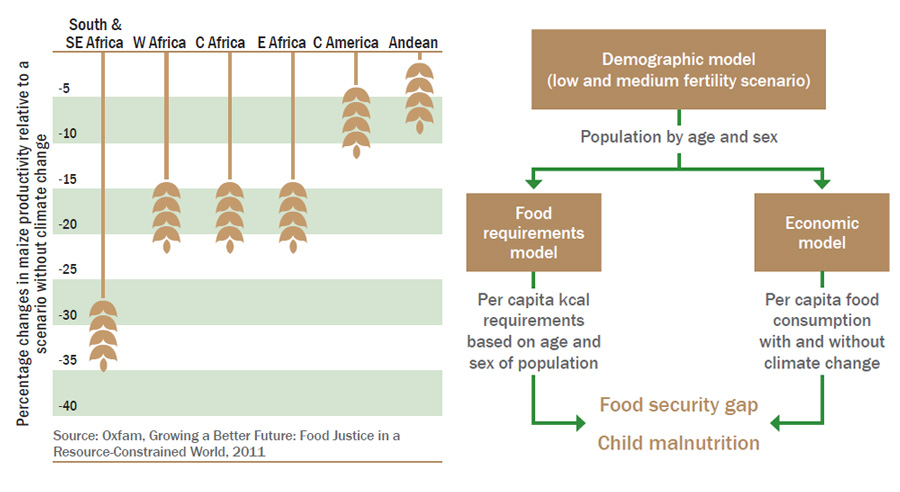-
Can Family Planning Save Millions From Malnutrition in a Warming World?
As the effects of climate change become increasingly apparent, existing poverty and human security challenges are being compounded. Among them, food security is one of the most pressing, especially in the developing world.
Based on a model developed by researchers at Futures Group, a pilot project in Ethiopia reveals that a lower fertility track for some countries could help compensate for the negative effects of climate change on agricultural yields. The study, conducted by MEASURE Evaluation and funded by USAID and The David and Lucile Packard Foundation, suggests incorporating family planning into existing climate change adaptation strategies.
Caloric Intake and Fertility Rates
Climate change can impact agricultural yields by shifting weather patterns and altering rainfall. For example, projections for African maize yields in 2030 are now 22 to 35 percent lower than they would be under a hypothetically unaltered climate, according to the study.
Futures Group, a global health consulting firm based in Washington, DC, combined three models – demographic, food requirements, and economic – to project caloric shortfalls under different population growth and climate scenarios.
Perhaps not surprisingly, demographic trends – specifically total fertility rate and the number of children under the age of five – make a big difference in the degree to which Ethiopia, a country of mainly subsistence farmers, will feel the effects of shifting rain patterns, higher temperatures, and more frequent extreme weather events (droughts and floods).
Under a medium fertility assumption (decline from 4.8 to 2.3 children per woman by 2050), Futures projects average per capita caloric consumption will decrease by more than 500 calories, contributing to 2.02 million malnourished children in 2050. Under a low fertility assumption (a decline to 1.8 children per woman by 2050), the caloric shortfall would be reduced to 127 per capita and the number of malnourished children would decrease to 0.98 million.
The study suggests that meeting the country’s unmet need for family planning can bend Ethiopia’s growth rate to the low fertility assumption and help make up for the negative effects of climate change on food security. Even though they have an expressed desire to stop having children or at least delay it, a quarter of married women in Ethiopia are not using any form of contraception, according to the report.
Critical Assumptions
The compounded effects of climate change on agricultural yields and high fertility rates on both total population growth and age structure (number of children under five) are profound. (Oddly enough, the caloric shortfall for the medium fertility assumption under a non-altered climate comes out to exactly the same as the low fertility assumption under a climate-altered future.)
But the model is perhaps more useful as a demonstrative exercise of the potential positive side effects of better reproductive health coverage than as a plausible simulation.
The GLOBE model Futures uses to predict economic development and food consumption changes is mainly concerned with international trade interactions and commoditized food prices. There isn’t any information about assumed changes to the underlying structure of the Ethiopian economy, and that missing ingredient is key to an accurate forward-looking picture, as it’s the high percentage of subsistence farmers that makes Ethiopia so vulnerable to changes in agricultural yields right now. Changes in urbanization (currently increasing at 3.8 percent a year), poverty rates (down nearly 6.0 percent since 2000), significant infrastructure improvements, and changes to market access could, and likely will, all make significant changes to how Ethiopians feed themselves over the next four decades.
The report itself also acknowledges several other limitations, namely its restrictive definition of food security and the simplicity of using caloric requirements as a substitute for nutrition. Defining food security as the gap between calories consumed and calories required for the entire population masks sub-national inequalities in food distribution and income.
Still, there’s a clear connection between food security in rapidly growing, climate-vulnerable countries and access to reproductive health, as the government of Ethiopia and many Ethiopian development organizations have acknowledged. And, as the authors put it, “the conditions facing Ethiopia are shared by many countries throughout the developing world.”
Besides the food security connections, there are also many other reasons to support efforts to empower women around the world through access to reproductive health.
While the messiness of climate and development models (some after all will surely make the argument that the climate projections used here are too optimistic or pessimistic) makes such forward-looking projections difficult, their value is in showing the connections between choices now, not necessarily as predictors of the future.
Sources: CIA World Factbook, Government of Ethiopia, MEASURE Evaluation, Oxfam, World Bank.
Image Credit: MEASURE Evaluation.
 A Publication of the Stimson Center.
A Publication of the Stimson Center.




